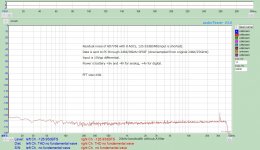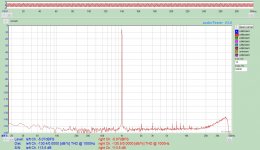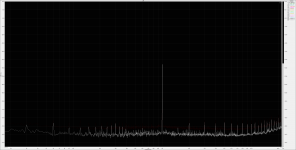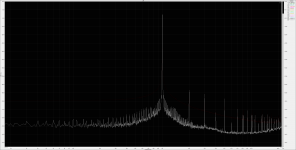I got my PCM4222EVM for free so I think mine was a good price
How did you manage that?
What are your goals with this?
I have just finished a USB sound card squeezing every db I can from CS5381 and CS4398.
I have to say that there are aspects that just dont jump out at you in designing (or pulling specifications from dark places).
To throw a number like -108dBc on the table as SINAD is doable, but to actually measure it requires balanced input test gear and isolation of - well everything!
If you intend to plug this into a signal source using RCA then you will be lucky to see your 50/60 Hz products at better than -100dB. With a tail wind.
DC isolation from the Pc's a big deal. Do you assume this?
Remember that -120dBc is 1 microvolt in a 1 volt system. This is 1mA earth current or differential current I a 1 milliom earth system.... say that slowly.
I assume you are aware that a CD with 16bit resolution zeroes out at -96dBc....
Back to the question... what is it you seriously expect of this and in what application?
I have just finished a USB sound card squeezing every db I can from CS5381 and CS4398.
I have to say that there are aspects that just dont jump out at you in designing (or pulling specifications from dark places).
To throw a number like -108dBc on the table as SINAD is doable, but to actually measure it requires balanced input test gear and isolation of - well everything!
If you intend to plug this into a signal source using RCA then you will be lucky to see your 50/60 Hz products at better than -100dB. With a tail wind.
DC isolation from the Pc's a big deal. Do you assume this?
Remember that -120dBc is 1 microvolt in a 1 volt system. This is 1mA earth current or differential current I a 1 milliom earth system.... say that slowly.
I assume you are aware that a CD with 16bit resolution zeroes out at -96dBc....
Back to the question... what is it you seriously expect of this and in what application?
It's better to have more than 126dBSNR ADC to measure recent DAC(AK4499), which already has achieved 120dBSNR. AD7768, which has 126.93dB(the 1st pic.), is one solution. But power quality(battery) and excellent isolation(optical interface) are mandatory even if your ADC chip is perfect. I have no experience with 24bit/192kHz, though AD7768 is free from noise increase at HF. Without an optical one, it would be difficult to have more than 126dBSNR.
As to THD, I'm not sure I can have more than 120dBTHD because my oscillator isn't guaranteed such a number. ADC for THD isn't the same setup as one for SNR. Eight ADCs version doesn't result in excellent THD. Two is better than eight in my PCB. The attached is the best performance. I don't think this is a true performance of AD7768 because there is a chance that DAC distortion cancels AD7768 one. Anyway, you need two PCBs: one for SNR, the other for THD.
As to THD, I'm not sure I can have more than 120dBTHD because my oscillator isn't guaranteed such a number. ADC for THD isn't the same setup as one for SNR. Eight ADCs version doesn't result in excellent THD. Two is better than eight in my PCB. The attached is the best performance. I don't think this is a true performance of AD7768 because there is a chance that DAC distortion cancels AD7768 one. Anyway, you need two PCBs: one for SNR, the other for THD.
Attachments
I'm interested in the challenge of pushing the limits and learning as I go. It's like squeezing more power or a faster lap time from a sports car.
One way to defeat the super DACs on the market today is to use a notch filter in combination with a tone from your oscillator. So if you just want your distortion measurements, that's the easiest way to achieve that. But it has limited use elsewhere.
This would ideally be a DC battery powered external module with a shielded enclosure, balanced input, and USB interface showing up in Windows as an audio input device. But that seems like a lot to ask for.
One way to defeat the super DACs on the market today is to use a notch filter in combination with a tone from your oscillator. So if you just want your distortion measurements, that's the easiest way to achieve that. But it has limited use elsewhere.
This would ideally be a DC battery powered external module with a shielded enclosure, balanced input, and USB interface showing up in Windows as an audio input device. But that seems like a lot to ask for.
Just for fun... Some measurements I just did of the ADC in my sound blaster sound card.
One sample at 1kHz tone @ -60dB for noise floor reference.
One sample at 1kHz tone @ 0dB
RCA input.
It's actually a bit better than I expected, right?
THD+N @1kHz = 0.004%
One sample at 1kHz tone @ -60dB for noise floor reference.
One sample at 1kHz tone @ 0dB
RCA input.
It's actually a bit better than I expected, right?
THD+N @1kHz = 0.004%
Attachments
This Mytek BROOKLYN ADC claims to reach a SNR of 130dB. $2000 isn't bad considering other products making the same claim are $10,000+
Brooklyn ADC – Mytek Digital
This is quite an achievement...
This is quite an achievement...
AK5578 in 8>1 mode or the AK5397 in 2>1 will do that with the right front end. No word on distortion though.
I am getting the shivers looking at the SMD PCB alone [see post 3]. How can any hobbyist solder something like that, is beyond me, and I have been soldering since my late adolescence.
They are easy enough to solder
The QFN package isn't the most DIY friendly. Still, at about $7 it hurts less to kill one soldering than if it were a $30 chip.
They aren't standard QFNs, at least the 5578 isn't. They've got little notches/chunks at the pins rather than the standard flat face of most QFNs. This makes them a lot easier/quicker to solder than regular ones.
- Status
- This old topic is closed. If you want to reopen this topic, contact a moderator using the "Report Post" button.
- Home
- Source & Line
- Digital Source
- Best ADC on the market today?



